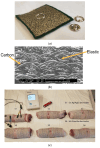Wearable Sensors and Motion Analysis for Neurological Patient Support
- PMID: 39727893
- PMCID: PMC11674467
- DOI: 10.3390/bios14120628
Wearable Sensors and Motion Analysis for Neurological Patient Support
Abstract
This work discusses the state of the art and challenges in using wearable sensors for the monitoring of neurological patients. The authors share their experience from their participation in numerous projects, ranging from drug trials to rehabilitation intervention assessment, and identify the obstacles in the way of the integrated adoption of wearable sensors in clinical and rehabilitation practices for neurological patients. Several highly promising developments are outlined and analyzed. It is considered that intelligent textiles are an attractive option, as they offer an esthetic outlook to and positive interaction with their users.
Keywords: intelligent textiles; monitoring; neurology patients; rehabilitation; wearable sensors.
Conflict of interest statement
The authors declare no conflicts of interest.
Figures






Similar articles
-
Advances in motion and electromyography based wearable technology for upper extremity function rehabilitation: A review.J Hand Ther. 2020 Apr-Jun;33(2):180-187. doi: 10.1016/j.jht.2019.12.021. Epub 2020 Apr 9. J Hand Ther. 2020. PMID: 32279878 Review.
-
Nanomaterial-Enabled Wearable Sensors for Healthcare.Adv Healthc Mater. 2018 Jan;7(1). doi: 10.1002/adhm.201700889. Epub 2017 Nov 30. Adv Healthc Mater. 2018. PMID: 29193793 Review.
-
Wearable sensors: At the frontier of personalised health monitoring, smart prosthetics and assistive technologies.Biosens Bioelectron. 2021 Mar 15;176:112946. doi: 10.1016/j.bios.2020.112946. Epub 2020 Dec 30. Biosens Bioelectron. 2021. PMID: 33412429 Review.
-
Interface sensors with skin piezo-thermic transduction enable motion artifact removal for wearable physiological monitoring.Biosens Bioelectron. 2021 Sep 15;188:113325. doi: 10.1016/j.bios.2021.113325. Epub 2021 May 18. Biosens Bioelectron. 2021. PMID: 34030098
-
A Review of Conductive Hydrogel-Based Wearable Temperature Sensors.Adv Healthc Mater. 2024 Oct;13(26):e2401503. doi: 10.1002/adhm.202401503. Epub 2024 Jun 19. Adv Healthc Mater. 2024. PMID: 38857480 Review.
References
MeSH terms
LinkOut - more resources
Full Text Sources
Medical

